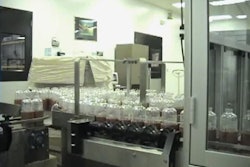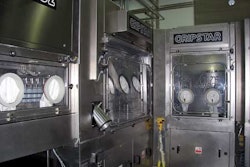Approved April 25, 2006, ANSI/PMMI B155.1 is a new safety standard for packaging machinery and packaging-related converting machinery. The standard describes procedures for identifying hazards, assessing risks, and reducing risks to an acceptable level over the life cycle of a piece of packaging machinery.
Chairing the ANSI/PMMI 155.1 Committee was Fred Hayes, director of technical services at the Packaging Machinery Manufacturers Institute (PMMI). Hayes agreed to join Packaging World in an August 3 conference call to tease out the implications of the new standard for both builders and buyers of packaging machinery. Also on the call were two additional members of the ANSI/PMMI B155.1 Committee: Bruce Main, president of safety consultancy Design Safety Engineering Inc., and Jeff Bloomer of Sara Lee Food and Beverage. Presented here is a portion of the August 3 conference call.
PW: Why a new safety standard? Hasn't safety always been at the top of the list where packaging machinery is concerned?
Hayes: You're right, it has. Look at any packaging show and it's plainly evident. Safeguards, interlocks, light curtains, and other safety devices are everywhere. But this standard changes things because it places so much emphasis on risk assessment. A lot of times in the past, people might look at a machine and say, “I have this type of hazard and so I'm going to put an interlock guard in place and that will prevent people from getting into the machine and injuring themselves.” But risk assessment brings a more structured element to it all. You pinpoint the hazard and ask how it can be mitigated. You get further into visualizing what people do, what tasks are they trying to perform, and how they interface with the machine.
PW: So it isn't that builders of packaging machinery haven't had safety on their agenda, it's just that they haven't been as rigorous in their approach to achieving safety through risk assessment?
Hayes: Their approach to risk assessment hasn't been as formalized as the new standard suggests they be. The new standard calls for a risk-scoring method. It requires the machine builder to pick some type of safeguarding device and then assess the probability and severity a second time to document that the risk has been reduced. It's this element of documentation that's really new.
Main: The primary requirement out of the standard is that risks have to be reduced to an acceptable level, and that's in Clause 5 of the document. As long as the manufacturer or user can do that and can demonstrate that they've reduced risk to an acceptable level, that's great. That is what the requirement is. The standard actually has a higher expectation now of being able to demonstrate what you've done. So what's new is the depth of the analysis that is now possible. The task-based approach that Fred talked about is really digging at a little deeper level than what we've been able to do in the past.
PW: I've heard it said that B155.1, whose chief objective is to bring about new levels of safety, should also bring greater levels of productivity and efficiency and even cost savings. That seems too good to be true. Why will it work that way?
Main: Because it will bring about a better understanding of what people are doing with machines at a deeper level. And once you understand that, the ways to make the machines better just kind of jump out at you.
Hayes: A lot of it depends on the approach you take to risk assessment. If you do the risk assessment two days before you ship the machine, you're going to have an assessment for the machine done, but you are not going to get any of the benefits of doing the assessment in terms of trying to find productivity gains and these other things. So really at that point, you've kind of added costs. On the other hand, if you do the assessment early in the design process, early enough to figure out what this machine is going to do and how it needs to meet the customer's requirements, then you can bring change to the design more cost effectively because you're dealing with ideas, CAD drawings, and things like that, as opposed to going out and cutting metal on the floor. So it's how and when you implement risk assessment that determines whether or not you get the gains in terms of cost reduction and productivity.
PW: Moving it forward from the earliest stages is the key?
Hayes: Correct.
Main: To a certain extent, OEMs will be verifying what they already know, which is that they make good machinery. We're not expecting them to go through this process and suddenly discover they've got all kinds of problems. So a lot of the work that they're going to be doing is really documenting and verifying that what they've done reduces risk to an acceptable level.
Bloomer: I would also think that this is a sort of a discovery process, so that what comes to light are newer technologies or other ways of mitigating a risk. I think the risk assessment is going to help people walk through that mental exercise of really identifying not the least-cost method of mitigating risk but the best method of mitigating risk.
PW: Jeff, when you say it's going to help people, do you mean OEMs or do you mean end users or a little bit of both?
Bloomer: Initially the OEMs. I mean they're going to take the first whack at the analysis. As an end user, we'll be in there scrutinizing the safety and the guarding. We'll do our own risk assessment, probably not to the level that the manufacturer does—we're looking at how the equipment is going to be used and how we anticipate it will be used. But it's not uncommon that once we get a piece of equipment installed and we get some training on it, and we get operators working on it, that other issues will surface. Hopefully, with a good risk assessment plan in place from the OEM standpoint, most of these other issues that come up are going to be things that are unique to us.
PW: What about liability? Will liability still be in the end user's hands, or will it shift more to the builders' hands?
Bloomer: I don't see it shifting to the OEM.
PW: It's still your responsibility?
Bloomer: Yes.
Hayes: I think from the standpoint of workers compensation and on-the-job injuries that it's the employer's mandate that they provide a safe workplace. I think by having the awareness of risk assessment in the process raised to a higher level, when companies like Sara Lee go out and request bids on projects, they're going to include in their specs better information regarding some of the operational parts of this equipment that's going to help the OEMs make better decisions. In turn, those decisions should help the end users run the equipment in a more efficient manner. From the standpoint of liability, if someone, for whatever reason, is injured on a machine, that employee certainly has the right to go back and litigate against the machinery builder if they feel that they've got a valid case. A lot of times some of that litigation is actually initiated by the workman's comp carriers.
PW: Back to Jeff for a minute if we may. What is the value of the new standard from an end users perspective?
Bloomer: I think Fred touched on it in part earlier. Packaged goods companies are in a very competitive business. There's more consolidation than ever, and globalization, too, has complicated things. We're having to source equipment not only within the U.S., but around the world. So having a machine safety standard like B155.1 helps give us a reference. Now we have a document that we can apply, so we can have certain expectations. We should know what we're going to get. That helps drive timely deliveries and least-cost installations. It should flatten our learning curve. It should flatten ramp ups. There is nothing more disruptive in a project than getting a piece of equipment into a facility only to have the on-site safety assessment reveal a whole bunch of issues. I think the B155.1 document is going to be an excellent tool for us to use and include as part of our specifications when we source equipment.
PW: How will the new standard be implemented at the OEM level? Will management at the companies that build packaging machinery need to do anything differently?
Hayes: I think the standard brings to the forefront the simple fact that there will be some management decisions that companies will need to make. One of them is defining what is acceptable risk. I mean in the past, engineers have taken that job on and done that without much guidance. And now we're really saying management needs to pay attention to this. And the other key to this is how you implement the risk assessment process. Whether, like I said, you do it two days before you ship the machine out the door, or whether you integrate risk assessment into your entire engineering and design and quotation process is going to make a big difference on the dividends that a company is going to receive.
Main: Think back to the early days of quality and introducing quality into a system. You know, there was an awful lot of resistance to that in many ways. Risk assessment is similar because many companies right now aren't doing this formally. One of the things management is going to have to change is to make time in their development schedules so they can do risk assessment and get their engineers and their safety folks involved. Schedules are tight. It's very competitive out there. And you've got to make the time available to get the value out of it, just like Fred was talking about. It will require a bit of a ramp-up effort just as we saw in the early days of quality efforts. The risk assessment process is not nearly as big, but it's going to be somewhat similar as far as changes that management has to make.
Hayes: OEMs are going to have to invest time and money on the front end in terms of getting people trained and looking at their system for processing work orders and such. They'll have to sort out how the risk assessment process is going to fit into all of that. Then, as they get down the road in year two or three, they'll start getting the rewards back in terms of engineering better products. The process by then will become more streamlined, until it's just another part of their business.
PW: I assume that with the publication of B155.1, buyers of packaging machinery will tell OEMs to take a hike if the OEMs can't demonstrate they're in compliance with B155.1. Is that too simplistic, or is there some truth in that?
Bloomer: I don't believe the adoption of the standard is meant to be a punitive measure. I view it a lot like the early days of sanitary design. And that was something that Sara Lee Food and Beverage worked on very closely with a lot of vendors. It's more of a partnership than anything else, a way of improving equipment design. The new safety standard is going to be the same way. There will be some initial, I don't want to say pushback, but there is going to be a learning curve for folks. The old adage is a rising tide floats all boats. You know, especially as projects are awarded to people that are following the standard and—lets face it, you know, the sales folks are calling us to sell us equipment. They always want to follow up and understand why they weren't awarded a particular project. If failure to adopt this standard keeps them from getting business, they're smart enough to catch on.
PW: Your reference to a partnership is interesting. It seems this notion is talked about more and more these days. Some are referring to it as “the integrated value chain.” It's the idea that you can't just let designers or machine builders or brand managers operate independently. They all need to be in on the same thing, sort of cooperatively or collaboratively, from the very beginning. Maybe the partnership concept you refer to is another example of that.
Bloomer: I look at it this way. Sara Lee as a company wouldn't want to be the only ones asking for this. Lets face it, in the early days of implementation, it could add some cost to the equipment, or it could add some time to machine delivery schedules. But as long as we're all working from the same document, it keeps the playing field nice and level, and I think the whole business segment benefits from it.
PW: How important is it that B155.1 is harmonized with international standards?
Hayes: From an OEM standpoint, harmonization is absolutely essential. You can't build two different machines to two different standards to ship to two different countries. It doesn't make good business sense. And from a legal liability standpoint, the absence of harmonization would be full of pitfalls that could have some pretty dire consequences. It just makes good business sense to build to the same standards and then be able to ship to wherever.
PW: Some are suggesting that the publication of B155.1 will bring a culture change to the world of packaging machinery. Anybody want to persuade me that this could really happen?
Hayes: It's a culture change in the sense that you're trying to get people to modify their approach to their engineering process. I think we'll see the impact more clearly two years down the road. Remember, implementation time in the standard is treated as a guideline, not a requirement. We feel that people are going to need probably 30 months to figure out how to implement this within their companies. It takes time to change a culture, and that's really what you're doing here, changing how people do business in terms of their engineering practices.
Bloomer: As soon as the end users start asking for documentation of the risk assessments, I think you'll begin seeing the impact of B155.1. It's similar to what we saw in the early days of sanitary design. We would approach manufacturers and ask if they were familiar with the AMI checklist and, you know, what sort of scores were they getting and that sort of thing. At first, people hadn't really adopted it. But now we have companies call us up and volunteer their AMI score. Again, I don't want to say it's the tail wagging the dog, but you know, once the end user starts asking for it, OEM companies will respond.
Hayes: I totally agree with Jeff's comments. The end users can drive this faster than anything that we as a trade association at PMMI, or any individual OEM in the industry, can do. End users will drive it because when they ask for it, believe me, they get OEM's attentions. And there is nothing wrong with that.
Main: Companies are either going to be doing risk assessment within the next five years, or they're going to cease to be significant players in the marketplace. It's just going to happen. Where is the downside? It takes a little while to learn it. Great, but you get a lot of benefit out of it. So they're either going to do it or they're going to be marginalized.
PW: Any final thoughts?
Hayes: I think like anything new, it is going to take people time to digest this and figure out how they handle it. I also absolutely believe that the element that is going to drive this more than anything else is going to be the end user community. At the same time, the OEM community will be attracted to it because of the harmonization issues and the advantage of not having to build different machines for different markets. But as Jeff observed, it's going to be the end users that make this happen.
Main: This is something that will have to evolve. Companies are going to start small. Maybe they'll start with one product line and figure out how it's going to work in their organization, and then they will roll it out. Large organizations, in some ways, have a bigger challenge—just logistically, the number of people, the number of different product lines. Smaller companies may find it easier because they don't face such complexity, but they don't typically have as much in-house expertise in risk assessment. So regardless of the company's size, it's going to take some time. And that's okay.
Bloomer: I couldn't have put it better.

























